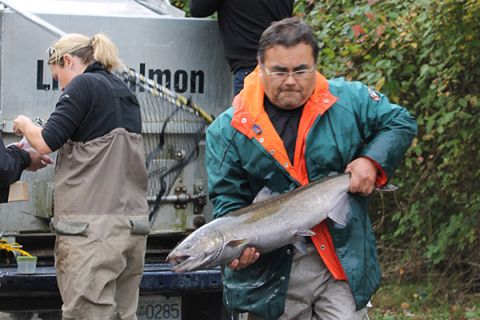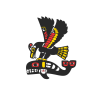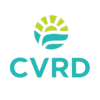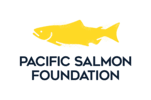by Peter Rusland, Cowichan News Leader Pictorial, Oct 30, 2014
 Long-term potential for a new Cowichan Lake weir — plus storage of some 20 centimetres of water next spring behind the current weir — is being discussed by stakeholders after Mother Nature narrowly saved our fish-spawning river.
Long-term potential for a new Cowichan Lake weir — plus storage of some 20 centimetres of water next spring behind the current weir — is being discussed by stakeholders after Mother Nature narrowly saved our fish-spawning river.
“Once we have direction from the (Cowichan Valley Regional District) board on the optimal long-term water-supply solution, we will be applying for a licence which we could use to hold a limited amount of additional water back, with the existing (weir) structure in place, while we build whatever new structure is necessary,” said CVRD Chairman Rob Hutchins.
Recent rains gave spawning coho and chum the flows to reach fall spawning beds after another summer drought left the Cowichan River threatening to run dry.
“I’m just hugely relieved; grateful is just not even the right way to say it,” Tim Kulchyski, Cowichan Tribes biologist, said of the averted salmon famine.
Still, a coalition of Tribes, Catalyst mill managers, CVRD leaders, and conservationists are sick of September nail-biting as the river reaches a trickle. They’re continuing pressure to solve lake-storage problems by spring.
“We don’t want to wait until next year,” said Crofton mill boss Rob Belanger. His company owns the 1950s weir regulating the water supply to its plant, and holds two provincial river-flow licences.
“It’s worthwhile getting all stakeholders in the room, and Catalyst is willing to take part in that discussion.”
Talks in the complex saga will include examining the costs and options of building a new weir that could cost taxpayers millions.
“The CVRD is studying the best plan and costs for building a new and higher weir to store more water by raising the weir, and having engineering drawings shovel-ready by late next spring to access any federal funds,” One Cowichan’s Parker Jefferson said of the long-term project.
Hutchins said staff is reviewing all options contained in the Cowichan River Basin Plan, developed about a decade ago.
“That report on the review of options would be completed and considered prior to commissioning any such engineering on any of the options,” he said.
Belanger was surprised to hear of a possible new weir, but hoped to explore more lake storage — though level numbers were pending.
“My understanding was they’re looking into getting some engineering work done and costs of what it would take to raise the current weir. We store the full (provincial) allotment of water tied to our permit. My understanding is we don’t have the ability to store any more water under our permit.”
That’s why the CVRD is analyzing how much water storage will be needed “over and above Catalyst’s existing licence”, Hutchins explained about raising the weir.
That’s a hot topic among some Cowichan Lake landowners who are awaiting a court ruling on how more storage could affect their property.
“There have been a number of proposals put forward and we want to review them in light of costs, new provincial requirements, climate change and other potential impacts,” Hutchins said. “Once that is done, a decision about who will put forward the (increased) water-licence request will be made, and the public consultation process will begin.”
Cowichan Tribes was supportive of that plan.
“In the short-term, we’re looking at supporting a weir improvement, or raising it,” Kulchyski said, “but we still have to sort out what that looks like, and what the actual numbers will be.”
All parties applauded Catalyst’s ongoing efforts to lower the mill’s water consumption.
“Toward the end of the drought, they dropped their consumption to 1.6 cubic metres per second, and were successful in some reductions, but we’re still concerned about the remaining flow, and how that pertained to fish values and passage,” Kulchyski noted.
River flows dropped from seven CMS to 4.5 this summer, “with the mill taking 1.6 CMS from that 4.5, so the river and fish got what was remaining.
“There are some real concerns what the remaining values of that flow is, and how it relates to fish health.”
Hutchins explained the mill has made “substantial” water-use strides through water recycling and reuse.
“They voluntarily use substantially less water than they are entitled to under their licence; as much as one-third less than their licence permits.”
He was unsure if Victoria could reduce the mill’s flow take “unless they repealed the original licence.”
Even then, “they would also have to reduce the amount they are licensed to hold at the lake, which would make our situation even more dire.”
Fish habitat, plus domestic, recreational and and industrial-water needs, will be debated by stakeholders now studying short-term lake levels toward 2015 storage.
Decisions will be helped by a new snow pack-meltwater measuring station on Heather Mountain, and river mapping to understand low-flow impacts on fish, Hutchins explained.
“Lowering (weir flows) too early also impacts our vibrant, robust small-drift boat industry, recreational fisheries, and summer recreation.”
 Email
Email



